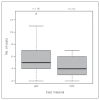Comparison of cast materials for the treatment of congenital idiopathic clubfoot using the Ponseti method: a prospective randomized controlled trial
- PMID: 25078929
- PMCID: PMC4119116
- DOI: 10.1503/cjs.025613
Comparison of cast materials for the treatment of congenital idiopathic clubfoot using the Ponseti method: a prospective randomized controlled trial
Abstract
Background: The Ponseti method of congenital idiopathic clubfoot correction has traditionally specified plaster of Paris (POP) as the cast material of choice; however, there are negative aspects to using POP. We sought to determine the influence of cast material (POP v. semirigid fibreglass [SRF]) on clubfoot correction using the Ponseti method.
Methods: Patients were randomized to POP or SRF before undergoing the Ponseti method. The primary outcome measure was the number of casts required for clubfoot correction. Secondary outcome measures included the number of casts by severity, ease of cast removal, need for Achilles tenotomy, brace compliance, deformity relapse, need for repeat casting and need for ancillary surgical procedures.
Results: We enrolled 30 patients: 12 randomized to POP and 18 to SRF. There was no difference in the number of casts required for clubfoot correction between the groups (p = 0.13). According to parents, removal of POP was more difficult (p < 0.001), more time consuming (p < 0.001) and required more than 1 method (p < 0.001). At a final follow-up of 30.8 months, the mean times to deformity relapse requiring repeat casting, surgery or both were 18.7 and 16.4 months for the SRF and POP groups, respectively.
Conclusion: There was no significant difference in the number of casts required for correction of clubfoot between the 2 materials, but SRF resulted in a more favourable parental experience, which cannot be ignored as it may have a positive impact on psychological well-being despite the increased cost associated.
Contexte: La méthode de Ponseti pour la correction du pied bot congénital idiopathique a de tout temps spécifié l’utilisation du plâtre de Paris comme matériau de choix; il y a toutefois certains inconvénients associés au plâtre de Paris. Nous avons voulu déterminer l’influence du matériau utilisé (plâtre de Paris c. fibre de verre semi-rigide) sur la correction du pied bot selon la méthode de Ponseti.
Méthodes: Les patients ont été assignés aléatoirement soit au plâtre de Paris soit à la fibre de verre semi-rigide en vue de l’intervention de Ponseti. Le principal paramètre mesuré était le nombre de plâtres requis pour corriger le pied bot. Les paramètres secondaires incluaient le nombre de plâtres en fonction de la gravité, la facilité de retrait du plâtre, la nécessité de sectionner le tendon d’Achille, le port assidu de l’attelle, le retour de la difformité, la nécessité d’autres plâtres et interventions chirurgicales auxiliaires.
Résultats: Nous avons inscrit 30 patients : 12 ont été assignés au plâtre de Paris et 18 à la fibre de verre. On n’a noté aucune différence entre les groupes quant au nombre de plâtres requis pour la correction du pied bot (p = 0,13). Selon les parents, le retrait du plâtre de Paris était plus difficile p < 0,001), prenait plus de temps (p < 0,001) et nécessitait le recours à plus d’une méthode (p < 0,001). Au moment du dernier suivi à 30,8 mois, les intervalles moyens avant un retour de la difformité nécessitant la pose d’un autre plâtre et/ou une chirurgie ont été de 18,7 et 16,4 mois dans les groupes traités au moyen de la fibre de verre semi-rigide et du plâtre de Paris, respectivement..
Conclusion: On n’a noté aucune différence significative entre les 2 matériaux quant au nombre de plâtres requis pour corriger le pied bot, mais la fibre de verre a donné lieu à une expérience plus agréable pour les parents, ce qui ne peut être ignoré en raison de l’impact potentiellement positif sur le bien-être psychologique, et ce, malgré un coût plus élevé.
Figures




References
-
- Pirani S, Zeznik L, Hodges D. Magnetic resonance imaging study of the congenital clubfoot treated with the Ponseti method. J Pediatr Orthop. 2001;21:719–26. - PubMed
-
- Roye DP, Jr, Roye BD. Idiopathic congenital talipes equinovarus. J Am Acad Orthop Surg. 2002;10:239–48. - PubMed
-
- Morcuende JA, Dolan LA, Dietz FR, et al. Radical reduction in the rate of extensive corrective surgery for clubfoot using the Ponseti method. Pediatrics. 2004;113:376–80. - PubMed
-
- Tindall AJ, Steinlechner CW, Lavy CB, et al. Results of manipulation of idiopathic clubfoot deformity in malawi by orthopaedic clinical officers using the ponseti method: A realistic alternative for the developing world? J Pediatr Orthop. 2005;25:627–9. - PubMed
Publication types
MeSH terms
Substances
LinkOut - more resources
Full Text Sources
Other Literature Sources
Miscellaneous
